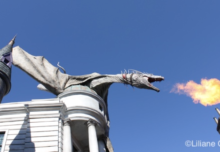You may know that October 20th is International Sloth Day, but did you know that Discovery Cove, home to hundreds of species of water-dwelling animals, is also home to a pair of two-toed sloths named Lucky and Luey? Part of their job is to remind visitors that all life on Earth is tied to water, and humans should take an active interest in conservation so they can protect the planet and all its creatures, no matter how sluggish those animals may appear.
Sloths get a bad rap – after all, they’re named for one of the seven deadly sins – because they appear to be quite content just hanging around idly and inching their way through life. In fact, sloths have a super-slow metabolism that allows them to conserve energy. They can burst into action in an emergency, but their unique adaptations help ensure that they rarely encounter a predator or other concern. Among those adaptations is the fact that because they move so slowly, it’s incredibly difficult for predators to spot them.
Sloths live in Central and South America, but it’s what lives ON them that’s truly amazing. Sloths’ fur, which runs in the opposite direction of most mammals’ coats because they so often hang upside-down, is home to algae that acts as a camouflage for the creatures and makes them even harder to spot … especially from the ground. Besides algae, various moths, beetles and other insects have been known to make their homes on sloths, which means that a mammal that appears to be quite listless is actually a bustling ecosystem within the rainforest.
Sloths also have remarkably strong, compact bodies and, of course, long claws that allow them to grip trees and do nearly everything – from eating to mating – upside-down. Lucky and Luey both love taking naps and sleeping in their rope hammocks. Luey is the earlier riser, and he’s often seen first thing in the morning, hanging with one of the park’s zoologists while a very lively group of humans ask questions about him. Lucky prefers to sleep in, dozing until mid-morning and then appearing at a “Conservation Cabana” session, with trainers between the park’s Wind-Away River and Fresh Water Oasis, or on perches along the river bank.
Lucky will be 18 years old in November and Luey will turn 10 next month. Both weigh about 15.5 pounds and enjoy a robust diet of romaine lettuce, yellow squash, mango, banana and “leaf-eater” biscuit. In the evenings as part of their enrichment program, both sloths enjoy snacking on hibiscus flowers, cecropia leaves and crape myrtle blooms. Sloths only move about 125 feet each day, and guests are often surprised to learn that sloths can swim.
About Discovery Cove: Only 1,300 guests a day enter the park, where they can also swim with dolphins (at an additional charge), hand-feed tropical birds, snorkel with colorful fish and play just inches from a family of otters. Discovery Cove is a paradise of rocky lagoons, tropical reefs, winding rivers, and pristine white-sand beaches in a lushly landscaped park that feels more like a secluded island than an easily accessible attraction in America’s vacation capital. A day’s admission includes breakfast and lunch, unlimited beverages and snacks, lockers, animal-safe sunscreen, snorkel gear, and parking. In addition, guests get unlimited admission to SeaWorld and Aquatica for 14 consecutive days around their Discovery Cove reservation.
For a complete review of all the is to do beyond Disney, check out Beyond Disney: The Unofficial Guide to SeaWorld, Universal Orlando, & The Best of Central Florida by Seth Kubersky. If you enjoyed this post, sign up for our newsletter here.





